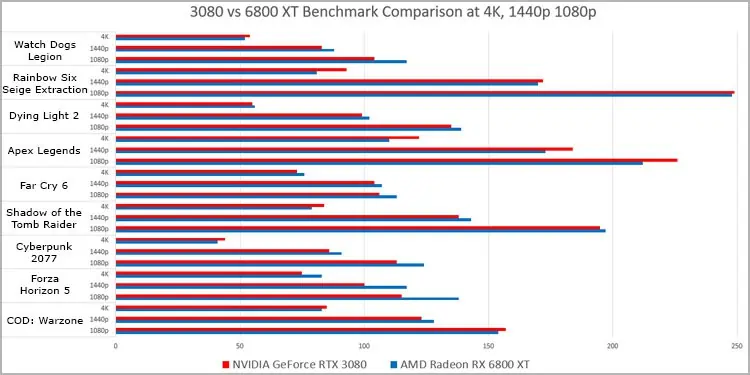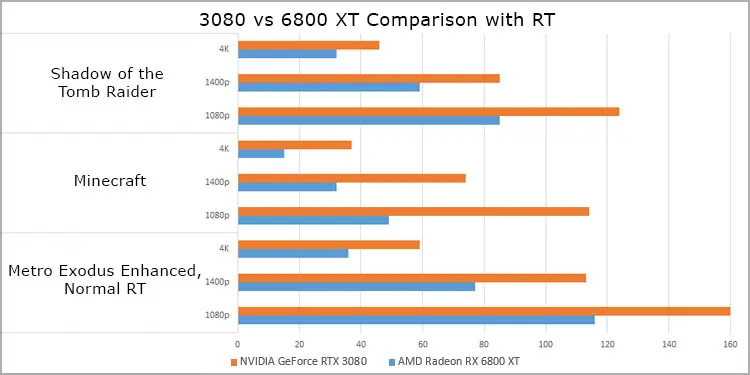Launched on October 28th and September 1st of the year 2020 respectively, AMD Radeon RX 6800 XT and NVIDIA GeForce RTX 3080 are both high-end graphics cards that supports DirectX 12 Ultimate.
This support allows both these devices to allow a realistic gaming experience because of its support for hardware ray tracing, mesh shaders, variable rate shading, and some other technologies.
However, the hardware and base technologies used in both graphics cards are significantly different. So, they do not provide the same performance across all games and other software.

Differences Between 6800 XT and 3080
Graphics Processing Unit (GPU) Cores
AMD’s Radeon RX 6800 XT has a Navi 21 variant GPU that uses the RDNA 2 architecture. In contrast to that, NVIDIA’s GeForce RTX 3080 uses the GA102 variant GPU with Ampere architecture.
Going into the differences between these GPUs will take a whole article. But the main thing is that Navi 21 has 5120 total cores or shaders and GA102 has 10752 total cores. AMD and NVIDIA both disabled some of the processing cores on these GPUs to reach the target number of 4,608 Stream processors and 8704 CUDA cores on 6800 XT and 3080 respectively. In the 12 GB version of 3080, NVIDIA enabled an additional amount of 256 cores, increasing the total count to 8960.
Now, while 3080 has an overwhelmingly high number of shaders, it does not directly correlate to performance. In GA102, half the number of CUDA cores are dedicated Single-precision Floating point (FP32) processors and the rest can work as either FP32 or Integer (INT32) processors. The Ampere architecture of GA102 also takes two cycles to resolve an instruction set or a thread group. In Navi21, however, all cores can be either FP32 or INT32 processors and RDNA 2 only takes one cycle to complete a thread group.

So, the main takeaway is thatyou can’t really utilize the difference in shaders to compare the two graphics cards. The points you actually need to analyze are some other specifications and benchmark tests that reflect real-world cases.
Clock and SGRAM/Memory
Youdon’t really need to consider the clock that much. In real use, the clock speed you’ll get will be different than both the base clock and the boost clock. Also, the clock only indicates the speed of one single instruction cycle. Each complete render takes a bunch of such instruction cycles and depends on other factors, such as bus width as well.
So, what you need to consider is the difference in thememory or SGRAM’s capacity and speed.
6800 XT provides 16 GB of SGRAM memory which is significant considering the 10 GB that the previous versions of 3080 used to provide. Now that, 12 GB models are also available, the difference is not that consequential. For most games, you won’t run into bottlenecks due to having this 4GB less memory. And for games where you do, both these graphics cards are not sufficient, so you’ll want to use higher-spec hardware anyway.
TheGDDR6X SGRAM on 3080 provides a much higher transfer ratecompared to GDDR6 on 6800 XT and you’ll experience fewer stutters and lags. With enough capacity, you’ll experience more smooth performance with GDDR6X.
For more information on the difference between these SGRAMs, we recommend checking out our article onGDDR6 vs GDDR6X.